The Japan bread-crumbs demand is valued at USD 58.3 million in 2025 and is forecasted to reach USD 95.1 million by 2035, indicating a CAGR of 5.0%. Demand is shaped by consistent utilization of breadcrumbs in fried food, coated meat, seafood, and convenience-meal formats. Broader consumption of ready-to-cook and ready-to-eat products, expansion of commercial foodservice outlets, and steady incorporation of coating systems in industrial food processing reinforce growth. Adoption in bakery, tempura preparation, and value-added meat applications continues to support the category.
Plain breadcrumbs lead the product landscape. These products are selected for stable texture, uniform granulation, and predictable performance during frying and baking. Their compatibility with Japanese home-cooking patterns and industrial production processes sustains widespread use across retail and commercial channels. Increased attention to moisture retention, coating adhesion, and heat stability influences product selection among processors.
Kyushu & Okinawa, Kanto, and Kinki record strong utilization due to the concentration of food manufacturers, cold-chain facilities, and quick-service restaurant networks. These regions also maintain efficient distribution structures that support continuous supply to processors and retail outlets. Key suppliers include Newly Weds Foods (Japan), Nisshin Seifun Group, Nippn Corporation, Showa Sangyo, and Yamazaki Baking. These companies provide plain, panko-style, and specialized breadcrumb variants used in processed foods, bakery lines, and large-scale commercial kitchens.
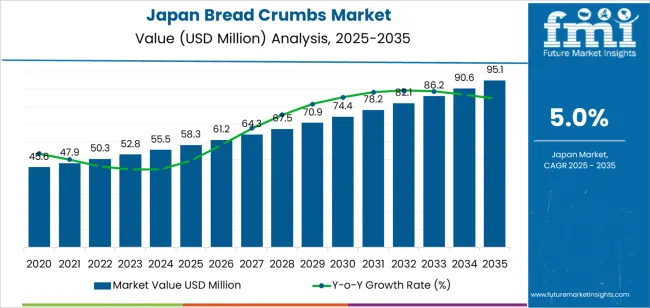
Peak-to-trough dynamics in Japan’s bread-crumbs segment show a stable progression with mild cyclical moderation rather than pronounced swings. Early-period performance reflects a peak phase supported by consistent demand from food-service operators, packaged-food manufacturers, and home-cooking consumers. Product usage remains steady due to its role in coated foods, ready-to-cook meals, and traditional dishes, creating a firm baseline for initial growth.
A soft trough appears in the mid period as consumption patterns level out across key segments. Growth moderates as food-service expansion stabilizes and household usage reaches a predictable rhythm. This trough remains shallow because bread crumbs retain broad functional relevance across Japanese cuisine, and demand does not experience strong seasonal or trend-driven fluctuations. Incremental product innovation and rising adoption of convenience foods help maintain a steady floor during this phase.
In the later period, the segment transitions into a renewed peak driven by greater penetration of frozen and ready-meal categories and expanded offerings by domestic manufacturers. Upgrades in production methods and wider distribution through retail and food-service networks strengthen late-cycle recovery. Overall, the peak-to-trough profile remains controlled and consistent, reflecting a resilient category with stable culinary and industrial applications.
| Metric | Value |
|---|---|
| Japan Bread Crumbs Sales Value (2025) | USD 58.3 million |
| Japan Bread Crumbs Forecast Value (2035) | USD 95.1 million |
| Japan Bread Crumbs Forecast CAGR (2025 to 2035) | 5.0% |
Demand for bread crumbs in Japan is increasing because food manufacturers and foodservice operators rely on panko and related crumb varieties for fried foods, ready-to-cook meals and convenience products. Panko remains a core ingredient in Japanese cooking, and expanding production of frozen seafood, coated meats and value-added meals sustains consistent use. Consumers continue to choose breaded items in retail and quick-service settings, which encourages processors to invest in higher quality crumb variants that improve texture and oil absorption.
Growth in premium and health-focused offerings, including whole grain and reduced additive formulations, supports demand in retail channels. Rising interest in home cooking and compact meal kits has also increased household purchases of panko. Constraints include fluctuations in wheat prices, competition from alternative coatings such as batter mixes or tempura-style products and the need for texture consistency across industrial production lines. Smaller manufacturers may postpone adoption of specialized crumb formats until demand or cost structure supports the change.
Demand for bread crumbs in Japan reflects established culinary preferences shaped by home cooking, retail food formats, and food-service requirements. Bread-crumb selection varies based on texture, dish preparation style, and suitability for frying or coating applications. Flavor preferences indicate the level of seasoning used in domestic and commercial kitchens. End-use distribution shows how Japanese consumers and manufacturers incorporate different crumb formats into soups, savoury items, prepared meals, and protein coating processes.

Plain bread crumbs hold 31.2% of national demand and represent the leading product type. Their neutral taste and adaptable texture support use in soups, patties, minced dishes, and binding applications common in Japanese meal preparation. Panko bread crumbs account for 27.5%, widely used for frying and coating due to their lighter structure. Italian bread crumbs represent 18.6%, supporting dishes requiring mild seasoning. Seasoned bread crumbs hold 13.9%, mainly used in convenience cooking. French bread crumbs represent 8.8%, serving niche baking and coating needs. Product-type distribution reflects textural requirements, household cooking patterns, and preferences across Japan’s packaged and fresh food settings.
Key drivers and attributes:
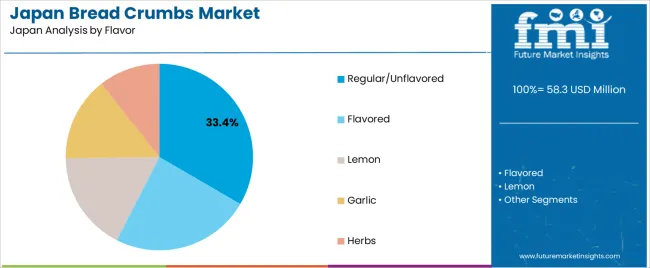
Regular or unflavored bread crumbs hold 33.4% of national demand and represent the leading flavor category. Their neutral profile aligns with versatile Japanese cooking practices that rely on adjustable seasoning. Flavored variants account for 24.1%, supporting ready-to-use coating mixes for at-home frying. Lemon-flavored crumbs represent 17.3%, often used in seafood dishes requiring light acidity. Garlic flavor holds 14.6%, supporting Western-influenced recipes in Japanese households and food-service kitchens. Herb-based crumbs represent 10.6%, serving prepared meals and bakery items. Flavor distribution reflects differing requirements for coating intensity, recipe customization, and convenience cooking in Japan.
Key drivers and attributes:
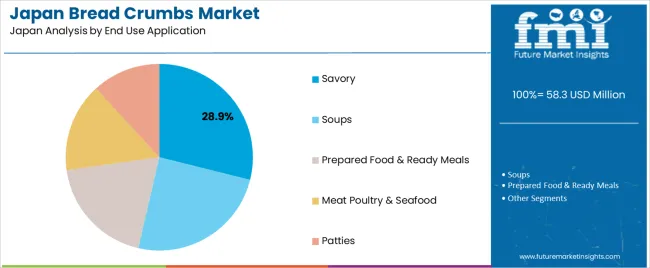
Savory applications hold 28.9% of national demand and represent the leading end-use category. Bread crumbs function as binders, thickeners, and coating agents in cutlets, croquettes, and daily home-style dishes. Soups account for 24.7%, where crumbs contribute to volume, texture, and thickening in traditional and contemporary recipes. Prepared food and ready meals represent 19.2%, supporting large-scale production of pre-fried or baked dishes. Meat, poultry, and seafood applications hold 15.4%, reflecting consistent use in breaded protein products. Patties represent 11.8%, supporting structural stability in minced-meat items. End-use distribution aligns with Japan’s strong reliance on convenience foods, protein coatings, and home-meal preparation.
Key drivers and attributes:
Growth of ready-to-cook seafood and meat categories, expansion of convenience-store prepared foods and sustained use of panko in domestic cuisine are driving demand.
In Japan, demand for bread crumbs is supported by strong consumption of breaded foods such as tonkatsu, ebi fry and croquettes, which remain staples across home kitchens and food-service outlets. Convenience stores, including leading chains in Kanto and Kansai, continue to expand fried and baked ready-to-eat items that rely on panko for texture and moisture retention. Frozen food producers in regions such as Hokkaido and Kyushu also increase use of bread crumbs for breaded seafood, especially shrimp and white fish, reinforcing steady industrial procurement. These factors collectively sustain high baseline usage across Japan’s retail and food-service channels.
Shrinking household size, reduced frying at home and strong competition from tempura and karaage coatings restrain growth.
Japan’s shift toward smaller households and reduced home cooking frequency limits household purchases of bread crumbs, especially among single-person and elderly households that avoid frying for convenience or safety. Many consumers prefer tempura batters or karaage coatings for quicker preparation, which reduces reliance on panko in daily meal routines. Some manufacturers also face cost pressure when bread prices fluctuate in regions with high wheat-import dependence, affecting breadcrumb production economics. These constraints moderate volume growth despite cultural familiarity with panko-based dishes.
Shift toward premium panko grades, wider adoption of freeze-stable coatings for frozen foods and increased use in bakery and confectionery textures define key trends.
Producers in Japan are introducing specialty panko varieties with airy texture, low-oil absorption and region-specific bread bases to support high-end restaurant and bento applications. Frozen food manufacturers are adopting freeze-stable breadcrumb coatings that maintain crispness during reheating, which is important for microwave-ready meals widely consumed in urban regions. Bakeries and confectioners in Japan increasingly use fine bread crumbs to add controlled texture in baked snacks and savory pastries. These trends reinforce diversified usage and support the continuing evolution of breadcrumb demand within Japan.
Demand for bread crumbs in Japan is increasing through 2035 as food-processing companies, restaurant chains, and households rely on panko, fine crumbs, and seasoned crumb blends for fried foods, coated ready meals, and bento components. Japanese manufacturers supply crumbs used in croquettes, katsu dishes, seafood coatings, and bakery applications. Convenience stores expand chilled and frozen coated foods, reinforcing procurement by processors.
Restaurants depend on consistent crumb textures for standardized frying performance across national and regional outlets. Households maintain regular use of bread crumbs in daily cooking routines, including home-prepared tonkatsu and vegetable fries. Demand varies across regions due to differences in food-processing clusters, consumption habits, and distribution networks. Kyushu & Okinawa leads with 6.3%, followed by Kanto (5.8%), Kinki (5.1%), Chubu (4.5%), Tohoku (3.9%), and Rest of Japan (3.7%).

| Region | CAGR (2025-2035) |
|---|---|
| Kyushu & Okinawa | 6.3% |
| Kanto | 5.8% |
| Kinki | 5.1% |
| Chubu | 4.5% |
| Tohoku | 3.9% |
| Rest of Japan | 3.7% |
Kyushu & Okinawa grows at 6.3% CAGR, supported by strong seafood-processing activity, high usage of panko in regional fried dishes, and steady household consumption across Fukuoka, Kumamoto, Kagoshima, Nagasaki, and Okinawa. Coastal processors produce breaded squid, shrimp, and fish fillets that require coarse and fine crumb formulations.
Bento suppliers in Fukuoka and Kagoshima expand production of fried components for convenience-store chains, increasing the volume of standardized crumb coatings used in daily meal sets. Local retailers offer multiple crumb varieties to match household cooking habits. Homes across the region prepare tonkatsu, karaage variations using crumbs, and fried vegetables for bento preparation. Small food manufacturers in Okinawa produce regional coated products for domestic distribution.
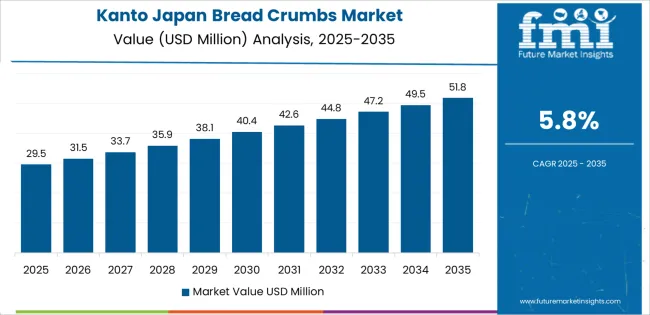
Kanto grows at 5.8% CAGR, driven by dense population centers, extensive convenience-store networks, and the presence of major food processors across Tokyo, Kanagawa, Chiba, Saitama, and Ibaraki. Large manufacturers in Tokyo and Kanagawa scale production of katsu, croquettes, fried seafood items, and frozen coated foods for nationwide distribution, increasing demand for fine and coarse panko.
Convenience chains rely on standardized crumb coatings for hot counters and chilled bento-meal lines. Restaurants serving tonkatsu, katsudon, and breaded seafood dishes generate consistent bulk demand for stable crumb textures. Households purchase seasoned, fine, and gluten-free crumb varieties for rapid meal preparation. Retailers expand offerings aligned with metropolitan cooking preferences.
Kinki grows at 5.1% CAGR, supported by active restaurant culture, regional bakery output, and stable domestic cooking patterns across Osaka, Kyoto, Hyogo, Nara, Wakayama, and Shiga. Osaka’s food-processing clusters produce croquettes, kushi-katsu components, and coated seafood products requiring uniform crumb adherence.
Bakeries across Hyogo and Osaka convert surplus bread into crumb material, reinforcing stable regional supply. Restaurants specializing in tonkatsu, kushikatsu, and mixed fry sets purchase panko in bulk for consistent coating performance. Households prepare crumb-coated dishes for evening meals and bento preparation, supporting retail sales of fine, coarse, and seasoned crumb varieties. Retail chains in Kinki stock multiple crumb types aligned with regional culinary traditions.
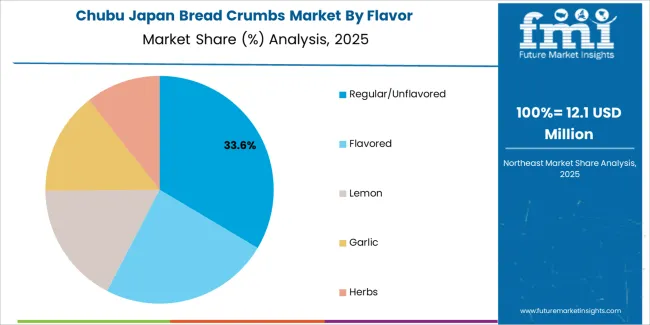
Chubu grows at 4.5% CAGR, shaped by food-processing clusters, regional seafood production, and consistent household consumption across Aichi, Shizuoka, Gifu, Mie, and Nagano. Manufacturers in Aichi and Shizuoka produce coated chicken, fish cakes, fried seafood, and ready-to-serve katsu dishes requiring panko and fine crumb textures.
Coastal processors in Shizuoka and Mie rely on crumbs for breaded fish and shrimp items distributed to supermarkets. Retailers offer multiple crumb varieties suited to daily home-cooking routines across the region. Households prepare tonkatsu, croquettes, and fried vegetables, increasing demand for consistent crumb options. Small-scale producers across Chubu manufacture locally distributed coated foods.
Tohoku grows at 3.9% CAGR, supported by coastal seafood-processing activity, regional bento production, and established home-cooking patterns across Miyagi, Aomori, Fukushima, Akita, Iwate, and Yamagata. Coastal processors rely on panko for breaded fish products distributed to regional supermarket chains. Bento suppliers in Miyagi and Fukushima prepare fried chicken, croquette components, and coated seafood elements that require consistent crumb texture. Households maintain steady but moderate crumb use due to traditional cooking routines involving tonkatsu and simple fried dishes. Retailers stock essential crumb varieties suited to regional demand. Local food producers manufacture coated items for distribution within Tohoku.
Rest of Japan grows at 3.7% CAGR, driven by small-scale food processing, regional restaurant activity, and stable household cooking across prefectures outside major metropolitan and industrial zones. Local producers manufacture breaded seafood, minced-meat croquettes, and coated chicken items for nearby retail networks. Restaurants in smaller cities depend on panko for fried menu items such as tonkatsu, menchi-katsu, and seafood fry sets. Households maintain regular crumb use for bento and dinner preparation. Retailers offer standard crumb varieties aligned with regional cooking preferences. Local supply chains support modest but consistent consumption volumes.

Demand for bread crumbs in Japan is shaped by domestic food-processing companies that supply panko and finely milled crumbs used in fried foods, ready-meal production, and foodservice operations. Newly Weds Foods Japan holds the leading position with an estimated 21.0% share, supported by controlled crumb-milling processes, consistent granulation, and long-standing supply relationships with Japanese frozen-food and meat-processing manufacturers. Its position is reinforced by stable quality and reliable nationwide distribution.
Nisshin Seifun Group is a major participant, providing panko and processed-food ingredients with dependable moisture control and steady texture characteristics used by large Japanese food producers. Nippn Corporation contributes significant volume across industrial and retail panko products, offering controlled crumb structure and predictable frying performance suited to tempura, tonkatsu, and breaded seafood applications.
Showa Sangyo maintains broad adoption through flour-based crumb products with consistent particle-size distribution and reliable supply for large-scale food manufacturers. Yamazaki Baking, a major bakery operator, supports additional demand with bakery-derived crumbs used in commercial food processing, emphasizing uniformity and stable cooking behaviour. Competition across this segment centers on texture stability, moisture regulation, granulation control, frying performance, and industrial-scale supply reliability. Demand remains steady as Japanese processors and foodservice operators continue to rely on panko and fine brown crumbs that provide consistent adhesion, crispness, and predictable behaviour across fried and ready-to-cook applications.
| Items | Values |
|---|---|
| Quantitative Units | USD million |
| Product Type | Plain Bread Crumbs, Panko Bread Crumbs, Italian Bread Crumbs, Seasoned Bread Crumbs, French Bread Crumbs |
| Flavor | Regular/Unflavored, Flavored, Lemon, Garlic, Herbs |
| End Use Application | Savory, Soups, Prepared Food & Ready Meals, Meat Poultry & Seafood, Patties |
| Distribution Channel | Retail, Food Service, HoReCa, Quick Service Restaurants, Travel Retail (Airplanes, Cruise Ships, Others) |
| Regions Covered | Kyushu & Okinawa, Kanto, Kinki, Chubu, Tohoku, Rest of Japan |
| Key Companies Profiled | Newly Weds Foods, McCormick & Company, Inc., Pinnacle Foods Inc. (Conagra Brands), Gonnella Baking Co., George Weston Foods Ltd. |
| Additional Attributes | Dollar sales by product type, flavor, end-use application, and distribution channel; regional consumption profiles across Japanese regions; competitive landscape and product innovation trends; integration with foodservice, retail, and travel retail channels. |
The demand for bread crumbs in japan is estimated to be valued at USD 58.3 million in 2025.
The market size for the bread crumbs in japan is projected to reach USD 95.1 million by 2035.
The demand for bread crumbs in japan is expected to grow at a 5.0% CAGR between 2025 and 2035.
The key product types in bread crumbs in japan are plain bread crumbs, panko bread crumbs, italian bread crumbs, seasoned bread crumbs and french bread crumbs.
In terms of flavor, regular/unflavored segment is expected to command 33.4% share in the bread crumbs in japan in 2025.






Our Research Products

The "Full Research Suite" delivers actionable market intel, deep dives on markets or technologies, so clients act faster, cut risk, and unlock growth.

The Leaderboard benchmarks and ranks top vendors, classifying them as Established Leaders, Leading Challengers, or Disruptors & Challengers.

Locates where complements amplify value and substitutes erode it, forecasting net impact by horizon

We deliver granular, decision-grade intel: market sizing, 5-year forecasts, pricing, adoption, usage, revenue, and operational KPIs—plus competitor tracking, regulation, and value chains—across 60 countries broadly.

Spot the shifts before they hit your P&L. We track inflection points, adoption curves, pricing moves, and ecosystem plays to show where demand is heading, why it is changing, and what to do next across high-growth markets and disruptive tech

Real-time reads of user behavior. We track shifting priorities, perceptions of today’s and next-gen services, and provider experience, then pace how fast tech moves from trial to adoption, blending buyer, consumer, and channel inputs with social signals (#WhySwitch, #UX).

Partner with our analyst team to build a custom report designed around your business priorities. From analysing market trends to assessing competitors or crafting bespoke datasets, we tailor insights to your needs.
Supplier Intelligence
Discovery & Profiling
Capacity & Footprint
Performance & Risk
Compliance & Governance
Commercial Readiness
Who Supplies Whom
Scorecards & Shortlists
Playbooks & Docs
Category Intelligence
Definition & Scope
Demand & Use Cases
Cost Drivers
Market Structure
Supply Chain Map
Trade & Policy
Operating Norms
Deliverables
Buyer Intelligence
Account Basics
Spend & Scope
Procurement Model
Vendor Requirements
Terms & Policies
Entry Strategy
Pain Points & Triggers
Outputs
Pricing Analysis
Benchmarks
Trends
Should-Cost
Indexation
Landed Cost
Commercial Terms
Deliverables
Brand Analysis
Positioning & Value Prop
Share & Presence
Customer Evidence
Go-to-Market
Digital & Reputation
Compliance & Trust
KPIs & Gaps
Outputs
Full Research Suite comprises of:
Market outlook & trends analysis
Interviews & case studies
Strategic recommendations
Vendor profiles & capabilities analysis
5-year forecasts
8 regions and 60+ country-level data splits
Market segment data splits
12 months of continuous data updates
DELIVERED AS:
PDF EXCEL ONLINE
Breadcrumbs Market Size and Share Forecast Outlook 2025 to 2035
Bread Crumbs Market Growth – Baking & Culinary Trends 2025 to 2035
Demand for Bread Preservatives in Japan Size and Share Forecast Outlook 2025 to 2035
Japan Faith-based Tourism Market Size and Share Forecast Outlook 2025 to 2035
Japan Sports Tourism Market Size and Share Forecast Outlook 2025 to 2035
Japan Respiratory Inhaler Devices Market Size and Share Forecast Outlook 2025 to 2035
Japan Halal Tourism Market Size and Share Forecast Outlook 2025 to 2035
Japan Automated People Mover Industry Size and Share Forecast Outlook 2025 to 2035
Japan Automotive Load Floor Industry Analysis Size and Share Forecast Outlook 2025 to 2035
Japan Food Cling Film Market Size and Share Forecast Outlook 2025 to 2035
Japan Polypropylene Packaging Films Market Size and Share Forecast Outlook 2025 to 2035
Japan Probiotic Yogurt Market is segmented by product type, source type, nature type, flavor type, fat content, sales channel and key city/province through 2025 to 2035.
japan Tortilla Market - Growth, Trends and Forecast from 2025 to 2035
Japan Cosmetics ODM Market Analysis - Size, Share & Trends 2025 to 2035
Japan Automotive Turbocharger Market Insights – Demand, Size & Industry Trends 2025–2035
Japan Yeast Market Insights – Demand, Size & Industry Trends 2025–2035
Japan Green and Bio-based Polyol Market Insights – Demand, Size & Industry Trends 2025–2035
Japan Natural Food Color Market Trends – Growth, Demand & Forecast 2025–2035
Japan Coated Fabrics Market Growth – Trends, Demand & Innovations 2025–2035
Japan Barite Market Growth – Trends, Demand & Innovations 2025–2035

Thank you!
You will receive an email from our Business Development Manager. Please be sure to check your SPAM/JUNK folder too.
Chat With
MaRIA